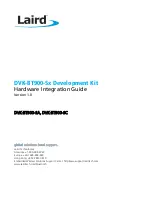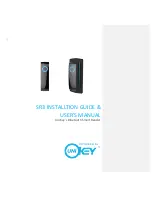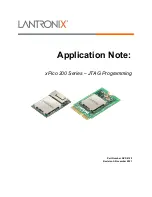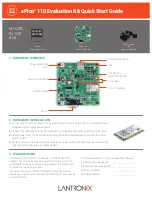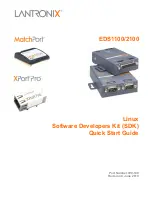
BT900 Development Kit
Version 0.3
Embedded Wireless Solutions Support Center:
http://ews-support.lairdtech.com
www.lairdtech.com/wireless
11
Laird Technologies
Americas: +1-800-492-2320
Europe: +44-1628-858-940
Hong Kong: +852-2268-6567 x026
Figure 5: J10 wiring to match FTDI USB to UART cable (TTL-232R-3V3 cable)
4.4
nAutoRUN Pin and Operating Modes
On the development board USB_DTR output (FTDI chip U9) from PC is wired to BT900 module pin 3 (nAutoRUN).
Note:
smart
BASIC runtime engine FW checks for the status of nAutoRUN during power-up or reset. The
nAutoRUN pin detects if the BT900 module should power up into Interactive/Development Mode (3.3 V)
or Self-contained Run Mode (0V). The module enters Self-contained Run Mode if the nAutoRUN pin is at
0V and an $autorun$ application exists in the modules file system, then the
smart
BASIC runtime engine
FW executes the
smart
BASIC application script automatically; hence the name
Self-contained Run mode.
The nAutoRUN pin inhibits the automatic launch $autorun$ application on power-up. Tying nAutoRUN to 3.3V
inhibits the $autorun$ application from running. The J6 3-pin header allows a jumper to be fitted to select between
the two operating modes.
Note: Micro DIP switch CON12 pin2-6 must be open when using J6 3-pin header to select nAutoRUN function.
Table 2: BT900 nAutoRUN pin
nAutoRUN
pin
BT900 Operating Mode
Interactive/
Development Mode
Self-contained Run
Mode
Circuit
J6 jumper
position
SIO_1
SIO_0
SIO_3
SIO_2
FTDI (USB to TTL 232 Cable)
GND
VCC_IO
J10
NOPOP (PIN HEADER,2.54mm 1X6P)
1
1
2
2
3
3
4
4
5
5
6
6
R72
(NOPOP) 0R
GND
RTS
VCC
RX
TX
CTS
GND
USB_CTS
VCC
USB_TX
USB_RX
USB_RTS
GND
R48
10K
R58
10K
VCC_IO_UART
USB cable plugged in: J6 Pin2-3 default
nAutoRUN: J6 Pin2-1
PIN HEADER,2.0mm 1X3P,
J6
1
1
2
2
3
3
nAutoRUN

